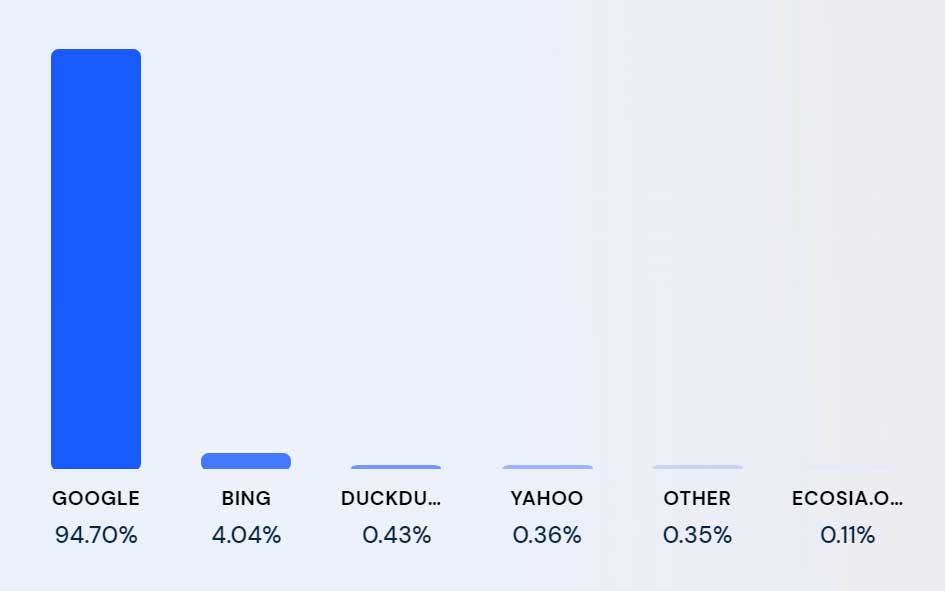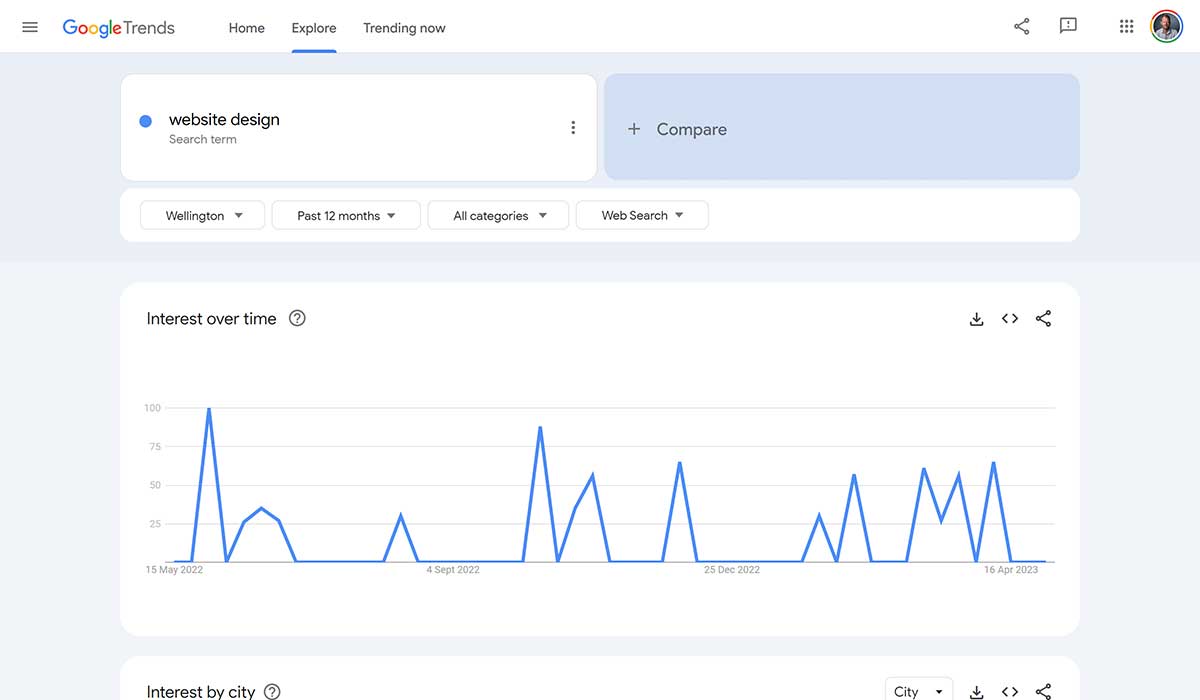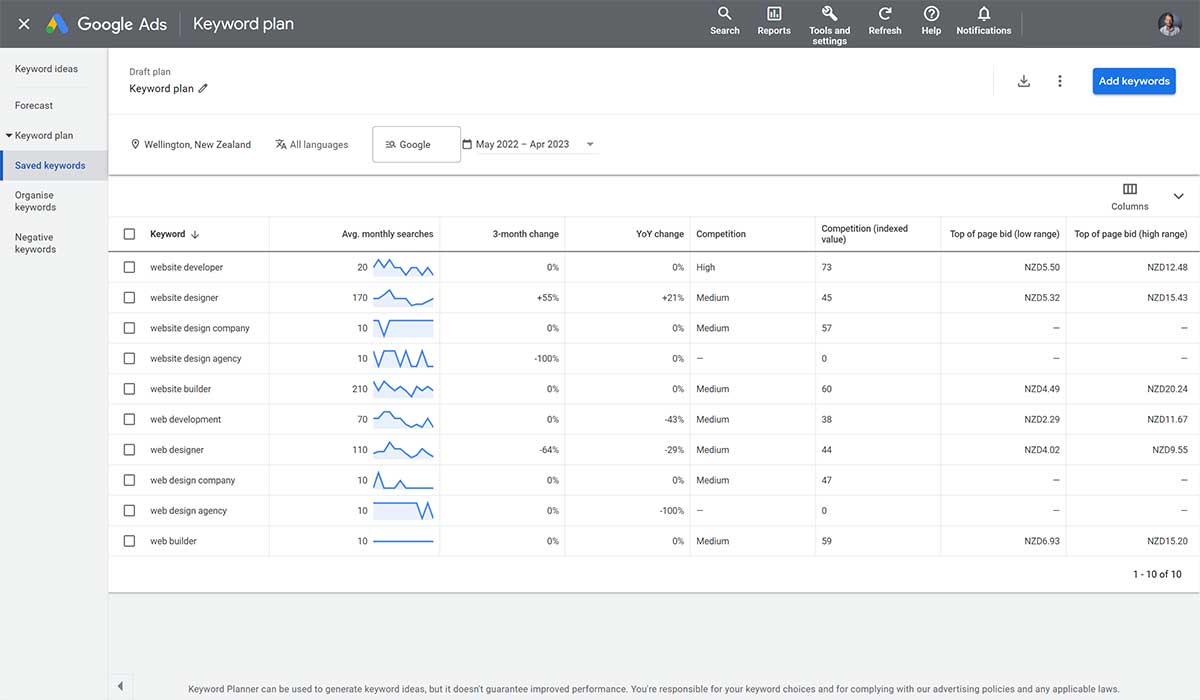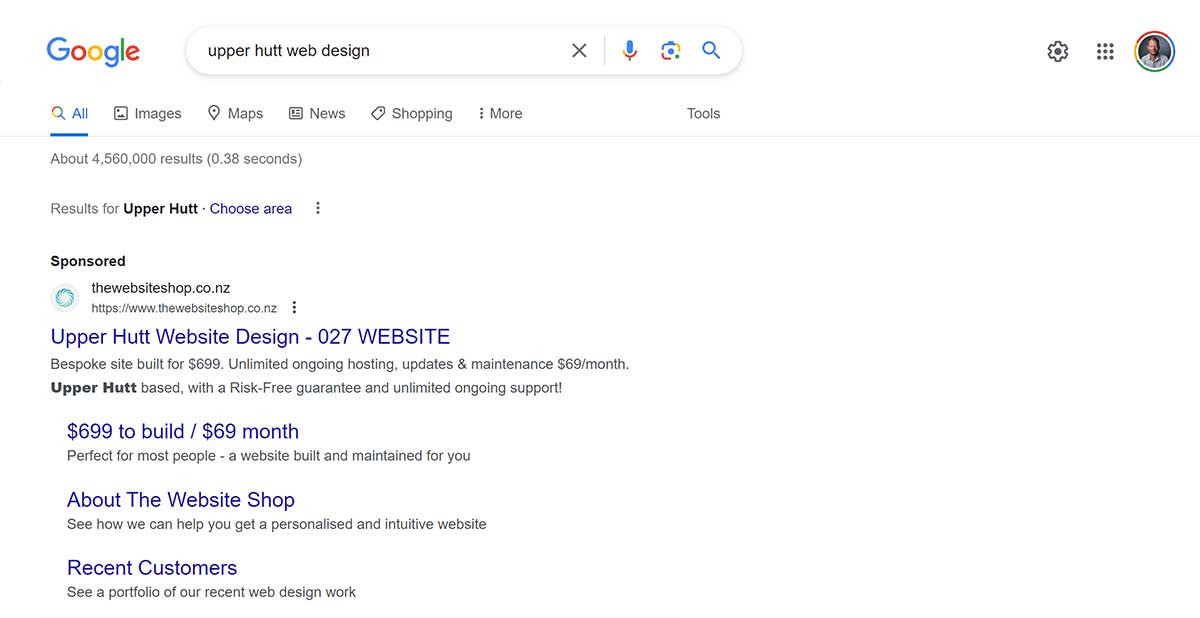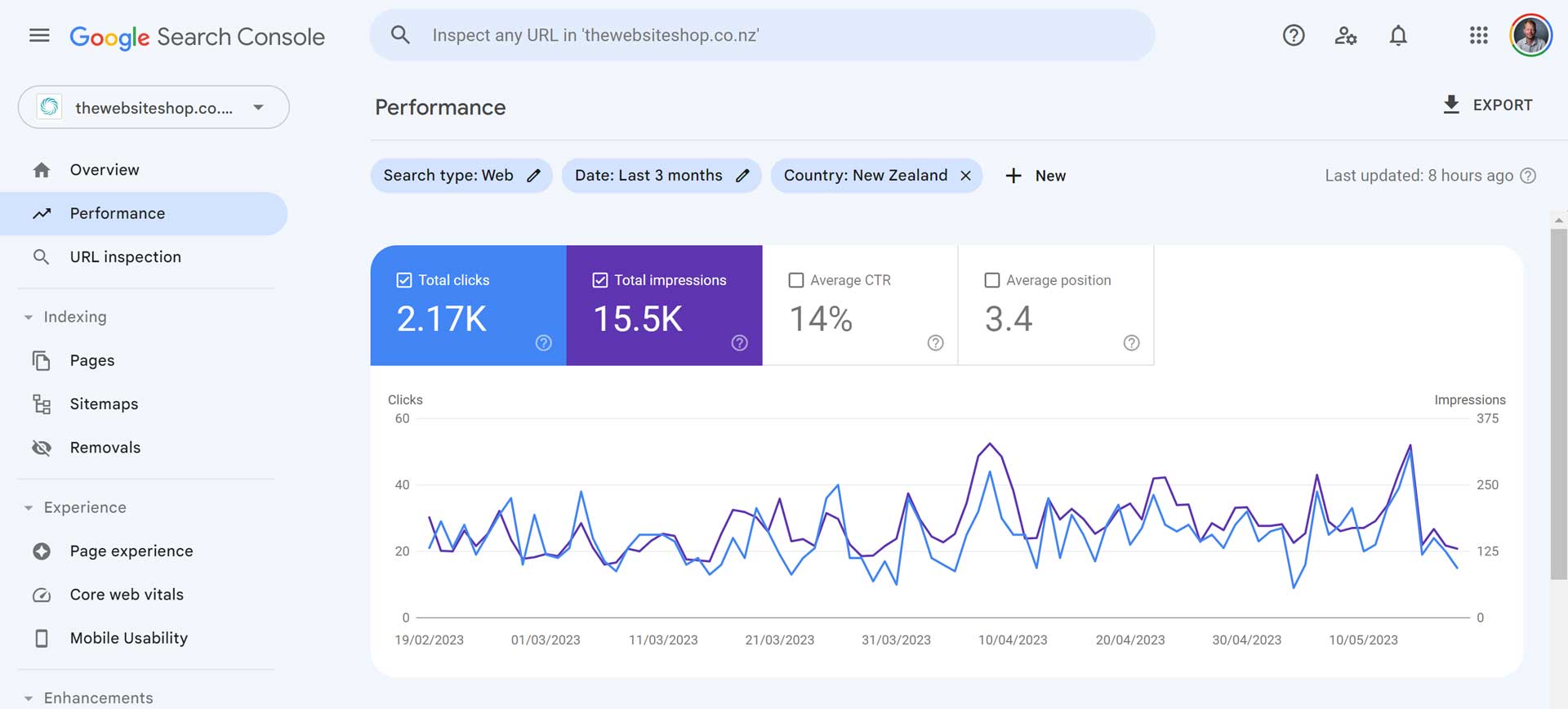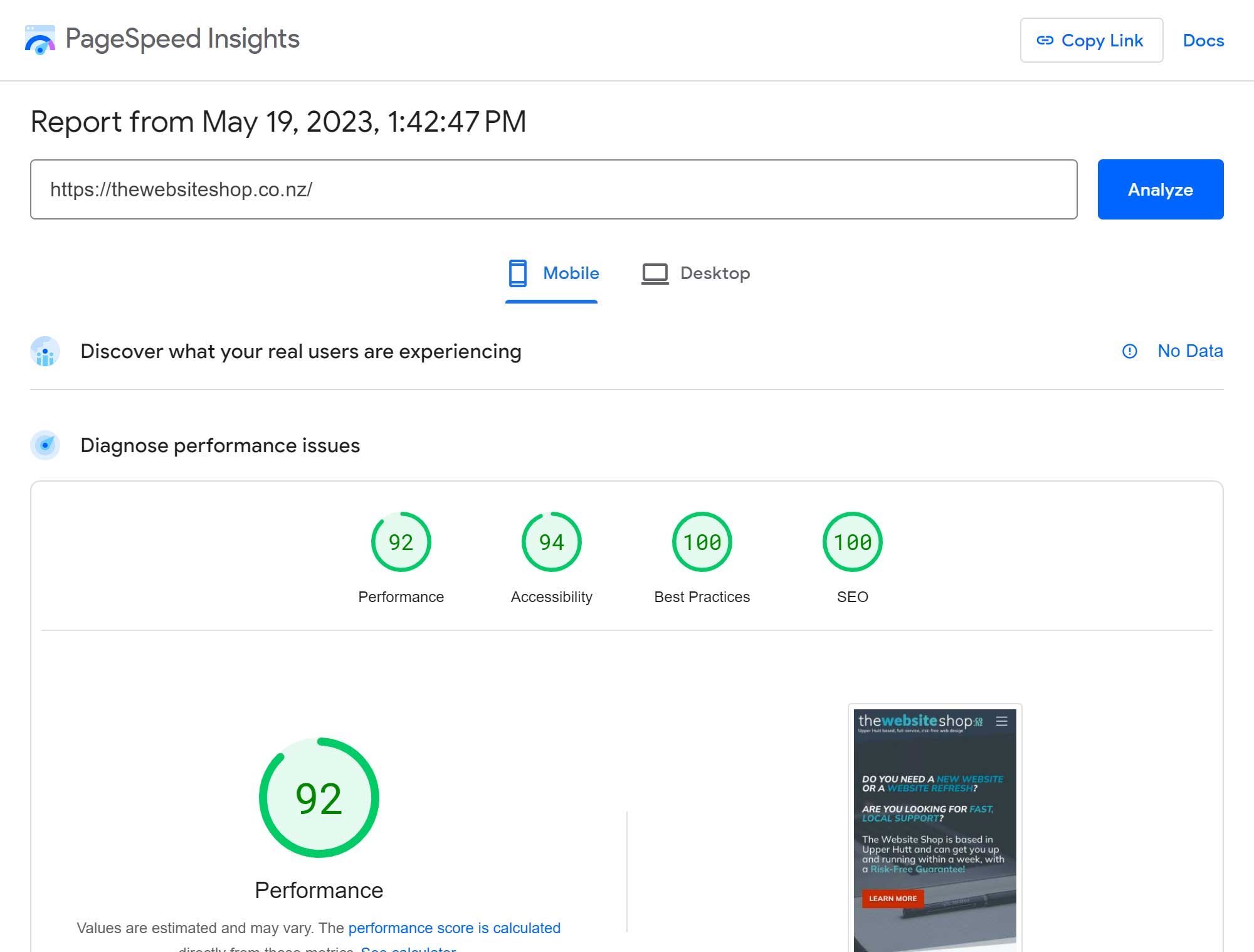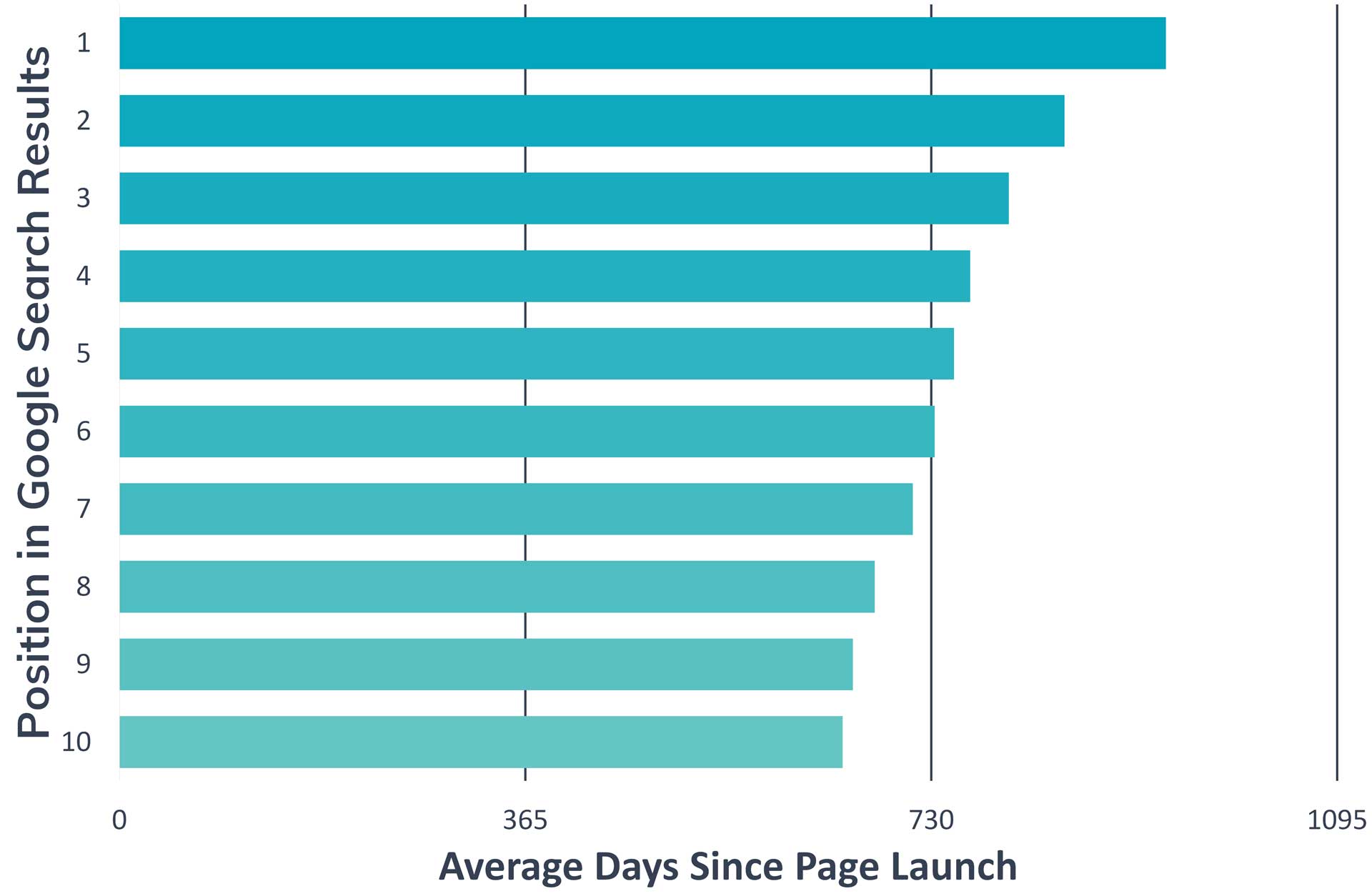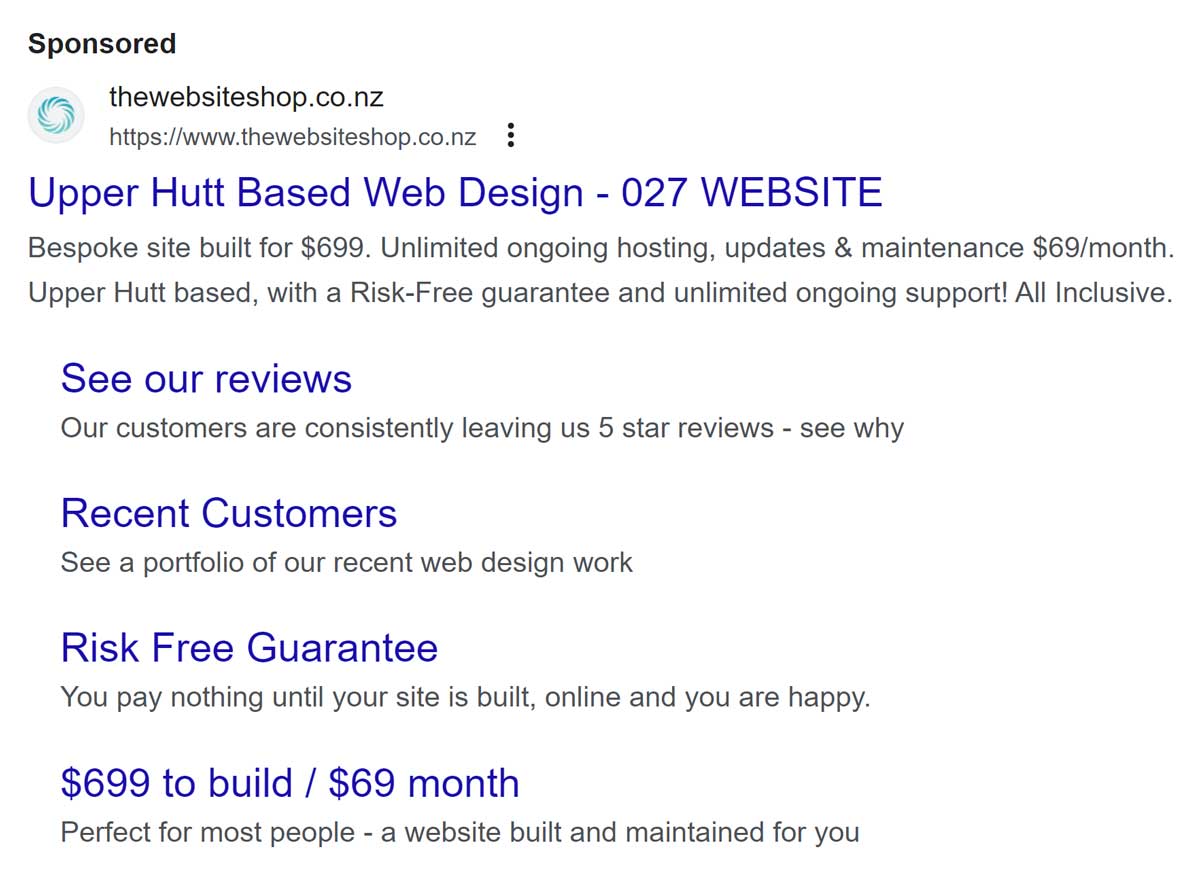Is your website not resulting in new leads?
If your website doesn’t seem to be doing anything, or you’re not getting the volume of customers you want, there are four (and only four) possible reasons.
We’ll cut to the chase and give you the four reason straight away. If your website is not giving you the leads you want, it’s either because:
- Nobody is searching for what you offer, OR
- People are searching, but you’re not showing up, OR
- You’re showing up, but people aren’t clicking on your business, OR
- People are visiting your site, but not converting.
If you read on, we delve more into how to check each of these reasons and how you can fix them.
But First, Does Your Website Need To Get You More Customers?
Before we go through the 4 reasons it’s important to ask – does your website need to be getting you more customers? It might seem like an obvious yes, but for many businesses, this is not the case.
There are two broad functions of a normal business’s website – to act as a source of information, and to convert customers. A conversion is the goal of most websites – whether that be a new customer calling you or buying your product online. Most websites perform both functions, but not necessarily equally.
If your website sits more in the source of information camp – then you might not get much benefit from this article. These websites are there more for people who know about your business already – either they are a current customer who is looking for more information, or a potential customer who knows about you from other channels and is looking for more information or to confirm that you’re a legitimate business. Often business like medical centres, who aren’t always looking for more patients, fall into this category.
If, however, your website is designed (either in whole or part) to help you convert new customers then… read on!
Reason 1
Nobody Is Searching For What You Offer
First have to determine if anybody is actually searching for what you’re offering. This one should be pretty straightforward. If you’re not in a niche category or a small geographical area, then it’s fairly likely that someone will be searching for what you offer. If you’re an Accountant in Wellington, common sense will dictate that people are looking for that. If you’re offering something like Rocket Design in Eketāhuna, you’ll no doubt have 100% market share, but there’s unlikely much of a market to share. A more realistic example might be a Mortgage Broker in an economic downturn – the number of people searching for your service might have dropped off completely.
SIDE NOTE
When we talk about search engines we’re generally only talking about Google (remember AltaVista and Yahoo Search?). Bing from Microsoft is making inroads, but with well over 90% of all internet searches in New Zealand and internationally made on Google, Google Search is the definition of market share.
In saying that, we shouldn’t write off Bing or other search avenues. If your market is specifically people who are less tech savvy (who may have never changed the default search engine from when they got their computer) or people who may not be allowed to change their default browser (e.g. work computers that are locked down) then Bing deserves attention.
Rather than rely on common sense, we can turn to the tools. There are a bunch tools (some free and some paid) that help us determine whether people are searching for something by region.
The first (I always turn to Google’s own products where possible) is Google Search Trends. Open up the site and pop in your search term. You’ll have the option in the results to filter by region. Google Search Trends is super easy, the downside is it only gives you trends volume not actual volume, and you can’t get too specific in your area (e.g. you can search results in Wellington but not in Upper Hutt).
Google’s Search Trends Tool
The second is to use the Google Ads Keyword Planner tool. You’ll have to create a Google Ads account (skip through all of Google’s effort to get you to set up an Ad) but you can get volume estimates for specific search terms by specific area, right down to individual suburbs.
Google’s Keyword Planner Tool
From here you should be able to determine whether there are actually any searches for your products and services in your region. If there aren’t then that’s the reason you’re not getting any leads from your website. If there are, we move onto Reason 2.
Reason 2
People Are Searching But You’re Not Showing Up
This reason is normally quite common. Ranking in a decent spot in Google’s organic search results can be hard. First, some background:
How Google Works
When you search for something on Google, there are three ways a result can show up: in the Paid Search Results, in the Google Business Listings, or in the Organic Search Results, normally in that order.
Paid Search Results (see picture below) are how Google makes most of their money. Businesses can pay to show Google Ads for a particular search term and location. How much varies wildly based on how much competition there is for a search term. Again, Accountant in Wellington is going to be expensive, Rocket Design in Eketāhuna, very cheap. These results are marked Ad or Sponsored and normally come up first. Running them can be very easy (Google makes it very easy to take your money). Running them successfully (profitability) can be a challenge.
Example of Paid Search Results
Google Business Listings (see picture below) are free and specifically target local businesses. If you want to be found on the web, it’s a mistake not to be in here. This area will showcase your business name, location, reviews (if you have any Google Reviews), contact details and hours, and is super simple to set up.
Example of Google Business Listings
Organic Search Results (see picture below) are what most people think about when they think about the search results. They’re free, but you also have the least control over it. Google’s computers continually visit and read every site they can find on the internet and try to determine if they are relevant to the searcher. Exactly how they do this is a closely guarded secret with over 200 factors influencing the result. Google keeps it secret because it doesn’t want people to game the system or competitors to copy how they do it, but they do let on a bit of information on how they determine search results.
Example of Organic Search Results
Generally (it’s a bit simplified), Google ranks pages in the organic results based on:
- relevance (how closely the contents on your page match what the searcher is looking for),
- popularity (if others have found your content helpful, this searcher is likely to as well) and
- usability (e.g. if your page is not optimised for mobile, you’re heavily penalised in the results).
They then place you based on where you rank on these factors compared to your competition. All this is straight from Google themselves. If you want to learn more about this, aim to get your info from Google directly as there is a lot of incorrect information floating around.
First Thing To Check – Does Google Know About You at all?
There are two parts to showing up in Google results. Making sure they know about you in the first place, and then Search Engine Optimisation (SEO). The first part is super easy. Jump over to google.com and pop your website address in the search box with the “site:” in front of it (e.g. site:thewebsiteshop.co.nz). This will show you all the results Google has from that website. If you don’t show up, there’s your problem. You need to register your site with Google. Jump onto Google Search Console, register your site and wait for Google to get around to crawling (reading with a computer) your site. This can take anywhere from a few hours to a week. If you find any pages in the results that don’t exist on your site anymore, you can request removal by using Google’s remove outdated content tool.
If it does show up, this isn’t the problem. Let’s move on to where you show up in the results.
Where You Show Up in The Results
Now that we’ve confirmed that Google knows about you, we need to find out how highly you feature in the results. This is a variable thing – where you appear will depend a lot on what someone searches, where they search from, what they’ve searched for before and how optimised your website is.
Saying “I want to rank on the front page of Google” isn’t enough information. We need to specify for what term and for what location.
The quickest and easiest way to assess this is to search yourself, but it’s also wise to get others to search for you as well. Your search history affects your current search results, and it’s likely you’ve been to your own website a few times before, so it might be ranking artificially high for you. Try searching using a different computer, a different browser and/or incognito mode, and do it a bunch of times as every search result is different.
Google Search Console can also show you your average position in the Organic Search Results from an independent point of view, and you can specify search term and location, but only as specific as country. That’s only really helpful if your target market is the whole county. For example, at The Website Shop, we generally focus locally, so seeing where I rank for the whole county doesn’t give me much insight.
Example of Google Search Console
If you’re showing up near the top for your desired terms and locations, you’re already most of the way there and you can move onto Reason 3. If you’re not then we need to look at optimising your page for the results via Search Engine Optimisation.
Improving Where You Are In The Results (SEO)
You may have heard the term Search Engine Optimisation (SEO). Generally, SEO covers two things:
- how easy it is for Google to read what’s on your page (the technical side of it) and
- how relevant the content on your page is.
For example, I may have a technically optimised site, but if the written content on the site focuses on the term website developer when website designer is significantly more popular, it’s not going to do me any favours.
SIDE NOTE
First, a warning. SEO is an industry in itself, with many high promises and dashed hopes. Google themselves warn you to be wary of any unsolicited SEO offer, or any promise to get you on the front page of Google:
No one can guarantee a #1 ranking on Google.
Beware of SEOs that claim to guarantee rankings, allege a “special relationship” with Google, or advertise a priority submit to Google. There is no priority submit for Google. In fact, the only way to submit a site to Google directly is through the URL Inspection Tool or by submitting a Sitemap, and you can do this yourself.
In fairness many companies that offer a “first page ranking or your money back guarantee” will be working to get your page ranked highly through legitimate means, but just accept that sometimes it won’t work and they will have to do a bit of work for nothing.
The guarantee in these situations is for your money back, not for the first page rankings.
SEO is part art, part science.
The science part is super easy to assess. Again, there are a bunch of tools out there (both paid and free), but the one I prefer to use is PageSpeed Insights, the free one created by Google themselves. Pop your website in there and see the results. PageSpeed Insights shows you how your website performs on four metrics – Performance (loading speed), Accessibility (how easy your site is to use for those with vision impairments), Best Practices (such as security) and SEO (the technical side of it). All four play a role for Google to some undisclosed level, and you’ll get advice here about what to focus on to improve the technical science side of your SEO.
Example of PageSpeed Insights
It’s important to note that performance is measured from either the United States, Europe or Asia, none of which are close to NZ. Distance plays a factor in how fast your page will load so if your website is hosted in the US and tested from the US it’ll perform better on this test than if your website is hosted in NZ and tested from US. However, if your customers are most likely to be searching from NZ – then it’s better to have your website hosted closer to here. If you have enough traffic to your site, Google will display real world insights which are more meaningful.
The art part is less easy to assess. You want to make sure that the key words that you wish to show up for are in your titles and that your content is clearly written around this. Google no longer focuses on the “keywords meta tag” that it used to (where website owners could list out the words that they wanted to show up for – it’s been abused too much over time). Instead, they attempt to read the site as a whole, as a human would, to determine what is important on the site.
You want to make sure that your content is written as clearly and as helpfully as you can for real visitor, and let Google do the rest. The only exception to this would be to make sure that your main titles tag (e.g. <h1>,<h2> and <h3>) have the titles that best describe your business categories, and that your meta description tag is worded as best as possible (covered in Reason 3).
SIDE NOTE
A warning about optimisation. You can spend a lifetime trying to get 100% on all four PageSpeed Insight metrics. The fastest website is going to be one with no images, no video, no analytics and no life. It’s a bit like the saying: the safest place for a ship is in the harbour, but that’s not what ships were built for. If having images, video and other content is going to help convert a visitor to a customer, then it’s worth having them. There’s no point optimising for getting visitors by forgoing converting to customers when they do arrive.
The optimisation tool should be used to make sure you’re not suffering any critical mistakes, not as a target. This video by Rich Harris has good insight, talking about Goodhart’s Law – “When a measurement becomes a target, it ceased to be a good measure”.
Make sure your site isn’t suffering unnecessarily from bad scores, but don’t chase high scores for the sake of high scores – there are heavily diminishing returns compared to spending the time on better content.
You’re Registered, You’re Optimised, But Not at the Top… Now What?
This is where most people find themselves. In short: you wait, or you pay.
Remember Google ranks your page roughly based on relevance, popularity and usability, and then places you based on where you rank on these factors compared to your competition. In theory if your site is well optimised (both in the art and the science), then you’ve ticked the relevance box and the usability box. Now all that’s left is popularity – which is a bit of a Catch 22 – to get to the top you need traffic, but to get traffic you need to get on top. Basically, the more people that legitimately visit your site (don’t pay for fake traffic) and the more people that legitimately link to your site (definitely don’t pay anyone for this), the higher you’re going to rank.
If you wait, this can happen over time, but it can take a long time. Google estimate most noticeable page rank changes take 3-6 months, and a study by ahrefs showed that the average age of a pages in the top 10 results of Google was around 650 days, and around 940 days for the number one spot.
Page Age vs Google Position Study
Understandably, most people don’t want to wait that long.
This is where advertising comes in. Either offline (newspaper, radio, flyers, getting into industry magazines) or online (Google Ads, Facebook Ads, posting in relevant Facebook groups). Again, this is another whole industry in itself.
One of the more popular methods is using Google Ads. Google Ads has a three major advantages over most forms of advertising:
- You’re paying to put your Ad in front of people who are specifically searching for what you offer (as opposed to putting it in front of the mass market, such as with newspaper or radio and hoping that someone will notice it). In fact, you can target people (with reasonable accuracy) by age, gender or location down to suburb or a 1km radius!
- It’s directly trackable. You know if somebody has clicked your Ad, what version of Ad they clicked (A/B Testing) and whether that person that has then left your site, made a purchase or filled out a contact form.
- You only pay once someone clicks your Ad, not for when they see it.
Google Ads isn’t perfect – it can take time, money and patience to get the right Ad showing, and some search terms can be particularly pricey to appear for. On the other hand – if you can figure out how much a sale is worth to your business and what proportion of site visitors end up making a purchase, you can determine how much you’re prepared to pay to for a click. You can also set a maximum budget you’re prepared to pay each month so it doesn’t get out of control.
While some people view this kind of advertising as an expense to the business, if it’s run well it should be viewed as an investment. If you have a well-run Google Ads campaign you should be earning more in profit than you’re paying in advertising.
Once you’ve got your business showing up in the Search Results (either organically or paid) we can move on to whether people are actually clicking on your business.
Reason 3
You’re Showing Up, But People Aren’t Clicking On Your Business
This reason is a bit easier to assess than Reason 2. Once you’re showing up in the search results (whether that be paid results, or organic results), you need people to click on your business so that you’re getting traffic to your site.
Measuring traffic to your site is easy. By far the most popular tool to do this is Google Analytics. If your site is not set up with Google Analytics or some other method of tracking traffic, you need to do this now.
Take a look at your Analytics report – if you’re getting a bunch of traffic then Reason 3 is not the cause of your problem, and you can move onto Reason 4. If you’re not getting much traffic, read on.
I’m Showing Up In The Search Results, But I’m Getting No Traffic
If you’re showing up in the search results – congrats, you’re already ahead of most people. Now you just need those impressions (showing up in results) to result in clicks.
You only have a small snippet of information to offer someone in the search results for them to decide whether to click on your business, but it differs based on whether you’re looking at the Organic or the Paid results.
Organic Results
In the organic (unpaid) search results you can display your website icon, website slug (which is normally the name of the page such as about-us or our-services), your website title and your website description. You can change these for every page on your site, but for each result that shows up the format is exactly the same. The goal here is to get a click – and these clicks don’t cost you anything, so they’re the best ones to get. You want to offer enough information to grab the searchers attention and get them interested enough to click.
Organic Search Result Example
If you’ve done your SEO Optimisation, the information you set in your meta description tag is the information that’s showing up here. If you’re reliably showing up in the results and not getting traffic, you’re going to have to talk a look at this and think about why people are not enticed to learn more by clicking it.
If you jump back into Google’s Search Console for your site, under the Performance tab there’s a list of organic queries that you’ve shown up for in Google search (Impressions) alongside the number of clicks that you’ve got for each one. Take a look at the search terms where you’ve got a low number of clicks compared to the impressions. These are the terms that you’re showing up for and not being clicked on. In some cases that’s fine (e.g. if the search term isn’t relevant to you), but if it is a search term that’s relevant to you, look at including these words in your meta description.
Paid Results
In the paid search results, you’ve got a lot more control and options. By this point you’re running Google Ads. This isn’t a Google Ads course (if you want one, I recommend Isaac Rudansky on Udemy, or for a free option search on YouTube), but you want to make sure you’re showing every extra bit of info (called Assets) that you can (assuming it’s relevant) – Business logo, Sitelinks, Call-outs, Structured snippets etc. You also want to be testing different combinations of information about your business to see what works best.
Paid Search Result Example with Site Links
Clicks from Paid Results are a bit different from Organic Results – they cost! Not every click is a good click, but Google also favour Ads that have a high Click Through Rate (proportion of times an Ad is show vs an Ad is clicked), so you want to put lot of time into narrowing the amount that your Ad is shown to only those times that are likely to result in a click, particularly developing your Negative Keyword List. A Negative Keyword List is a list of terms that will block your Ad from showing. For example, for The Website Shop I’d be blocking the terms “Class” and “Lesson” as I don’t want to show up when someone searches for “Website Design Lesson”.
Jump into your Google Ads account and look for “Search terms”. This will show you a list of all (or at least most) of the terms that have triggered your Ad. Just like with the Organic result search terms, you’re looking for terms that you want to show up for that have a low click to impression ratio (Click Through Rate) to determine where to place your focus. If you see terms that are triggering Ads that are not the kind that you want to pay for – then you’ll want to add those to your Negative Keyword List.
Once you’ve got a good amount of traffic to your website, you want to move on to Reason 4.
Reason 4
People Are Visiting Your Site, But Not Converting
If you’re getting plenty of traffic to your site but it’s not resulting in any leads, then there’s a few things left to check:
Are You Getting the Right Kind of Traffic?
It’s all very well that people are visiting your website – but are they the right kind of people who are looking for what you’re offering in the first place? If I’m running an Ad for Website Design Services but it’s triggering people who are searching for “How to become a website designer” or “Web design courses” then I’ve got the wrong kind of traffic. There are two ways to check what people are looking for when visiting your site, one for Organic Traffic and one for Paid Traffic.
For Organic traffic – jump into the Performance tab in Google’s Search Console and check what search terms are resulting in clicks. If they’re mostly relevant then you’re probably getting the kind of traffic you want. If you’re getting the wrong kind of traffic (i.e. most of your high volume search terms that have resulted in a click are not relevant to your business) you’re going to have to go back to Reason 3 and work on the quality of your meta description so you’re getting the right kind of traffic.
For Paid traffic – do the same, but with your Search Terms report within your Google Ads account, and adjust your Ads as necessary.
There’s a third category of where you traffic can come from that we haven’t mentioned – direct traffic. These are people who have typed your website directly into the browser (i.e. haven’t come from a search engine). These people already know about your business or have seen your advertising somewhere else offline (flyers, advertising etc). This information can be found within your Analytics. If you’ve got a lot of direct traffic it’s impossible to know whether the visitors are the right kind of people who are looking for your services, but have a think about any advertising you’ve done (including any signage outside your business, if relevant) – is it clear what services you provide?
The other thing to check is the demographics of your traffic or specifically the location it’s coming from (for all three sources). Again, this can be found withing your Analytic system. Make sure (assuming you’re marketing locally), that the traffic is coming from the right country. If it’s not, you’re back to Reason 3 – you may be getting traffic, but it’s not the right kind. Make sure you’ve location restricted any Ads and include your location in your meta description or Ad text if needs be. Make sure you’re using a .nz domain if your target is primarily NZ (.co.nz, .net.nz, .org.nz, .nz are all fine, just not .com unless you’ve got an international target).
If all the above steps have shown that the traffic you’re getting is relevant, we move on to making sure your website is working correctly.
Is Your Website Working Correctly?
This one can be a hidden problem, because there are so many variables as to what could cause problems with your website. Even if the website looks normal to you, it might not to other people. A few things to check:
- Log out of the site (if you have admin access) and open it from a completely new computer or browser – if you’re site has been infected with any malware then you likely won’t see the effects if you’re logged in as an admin. Make sure you’ve got good anti Malware software included and are using secure passwords.
- Check how the site looks on different devices (computers, tablets, phones), and different browsers (Chrome, Edge, Firefox, Safari), and different operating systems (Windows, Apple). Expect some slight variations, but you’re looking for anything that looks wrong (at The Website Shop we check all of our customers sites every day to ensure they are loading correctly and looking normal).
- Make sure your site has Up Time monitoring (checking to see if the site goes down). We check every customers site every 5 minutes to make sure it’s online.
- Check that all of your links (especially phone and email links) are correct, and bring up the right number/email when you click them.
- Check that any contact form is working.
If everything is in working order, move on to the next step.
Is Your Website Set Up for Conversions
In the website world, a conversion is any action that is the goal of your site. If you’re an online shopping site a conversion would likely be a sale, if you’re a salon a conversion would likely be a booking. For The Website Shop – it’s someone contacting us that is interested in a website. Every site is different.
On your site, your desired conversion needs to be super easy and super obvious – you don’t want people to have to look around to find out how to get hold of you or buy a product.
It’s also wise to look at the wording and pictures you’re using. There is a whole industry in itself set up to cater for writing the perfect text, but you want to be thinking about what problem your customer likely has, and how you’re going to solve that. Take a look at your text, how many times does “I” or “me” occur compared to “you” or “your”. Does the content on your site talk about you and the features that your company offers, or does it talk about the customer and the problem you’re solving for them? A good book to read is Sell Like Crazy by Sabri Suby.
Finally, you could spend a lifetime perfecting your website to optimise for conversions (and if you’re getting a ton of traffic but no conversions it’s probably a good place to focus) however there’s one more thing to consider…
Maybe He’s Just Not That Into You
The final reason is, maybe your offer is not attractive enough to people. By this point, you’ve got a healthy amount of traffic coming to your site, from people who are looking for the services that you offer, and (if you’ve optimised your site for conversions) you’ve made it as easy and as motivating as possible for people to convert – maybe there’s something about your offer that’s holding them back?
There’s no way to measure this except for your experience within your business. If you’re getting plenty of sales offline, then this is unlikely to be the problem. If you’re sure that your offer is compelling (again I’d recommend the Sell Like Crazy book by Sabri Suby to learn more), then you’re back to shuffling through the reasons above.
IS IT ALL A BIT TOO MUCH?
The aim with this article was to write a comprehensive list of what could be causing your site to not generate the leads you want. If you’ve answered yes to everything but you’re still not getting what you want, then you’re going to have to trawl back through them one by one to double check – as there are no other reasons that your site might not be converting other than:
- People aren’t searching for what you’re offering, OR
- People are searching, but you’re not showing up, OR
- You’re showing up, but people aren’t clicking, OR
- People are clicking, but they’re not converting.
If it’s all a bit too much – give me a call on 027 WEBSITE. I’m happy to talk through your business and your website on what you’re trying to achieve – even if it doesn’t lead to a conversion!
Let’s Chat
Pop your details below, call me or send me an email and we can have a no-obligation chat about what you’re looking for and if The Website Shop is the right fit for you.
If we’re not, we’ll answer your questions and point you in the right direction to get you sorted!

